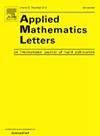一般哈密顿偏微分方程的拉格朗日乘子方法
IF 2.8
2区 数学
Q1 MATHEMATICS, APPLIED
引用次数: 0
摘要
通过引入拉格朗日乘子方法,提出了一种新的线性隐式保能方案。与以往的标量辅助变量(SAV)方法不同,该方法不要求能量的非线性部分从下有界,并且在连续和离散情况下都保留原始能量。此外,我们为这些优势所付出的代价是必须求解一个非线性代数方程来确定拉格朗日乘数。结合拉格朗日乘子计算成本不占主导地位的数值实验,我们证明了新方案与SAV方法相比计算效率高,并且准确地保留了原始能量。本文章由计算机程序翻译,如有差异,请以英文原文为准。
The Lagrange multiplier approach for general Hamiltonian PDEs
A novel linearly implicit energy-preserving scheme is proposed for general Hamiltonian PDEs by introducing the Lagrange multiplier approach. Unlike the previous scalar auxiliary variable (SAV) method, the new approach does not require the nonlinear part of the energy to be bounded from below, and conserves the original energy in both continuous and discrete cases. Moreover, the price we pay for these advantages is that a nonlinear algebraic equation has to be solved to determine the Lagrange multiplier. Combined with numerical experiments, where the computational cost of the Lagrange multiplier is generally not dominant, we show that the new scheme is computationally efficient as the SAV method, and that it accurately preserves the original energy.
求助全文
通过发布文献求助,成功后即可免费获取论文全文。
去求助
来源期刊

Applied Mathematics Letters
数学-应用数学
CiteScore
7.70
自引率
5.40%
发文量
347
审稿时长
10 days
期刊介绍:
The purpose of Applied Mathematics Letters is to provide a means of rapid publication for important but brief applied mathematical papers. The brief descriptions of any work involving a novel application or utilization of mathematics, or a development in the methodology of applied mathematics is a potential contribution for this journal. This journal''s focus is on applied mathematics topics based on differential equations and linear algebra. Priority will be given to submissions that are likely to appeal to a wide audience.
 求助内容:
求助内容: 应助结果提醒方式:
应助结果提醒方式:


